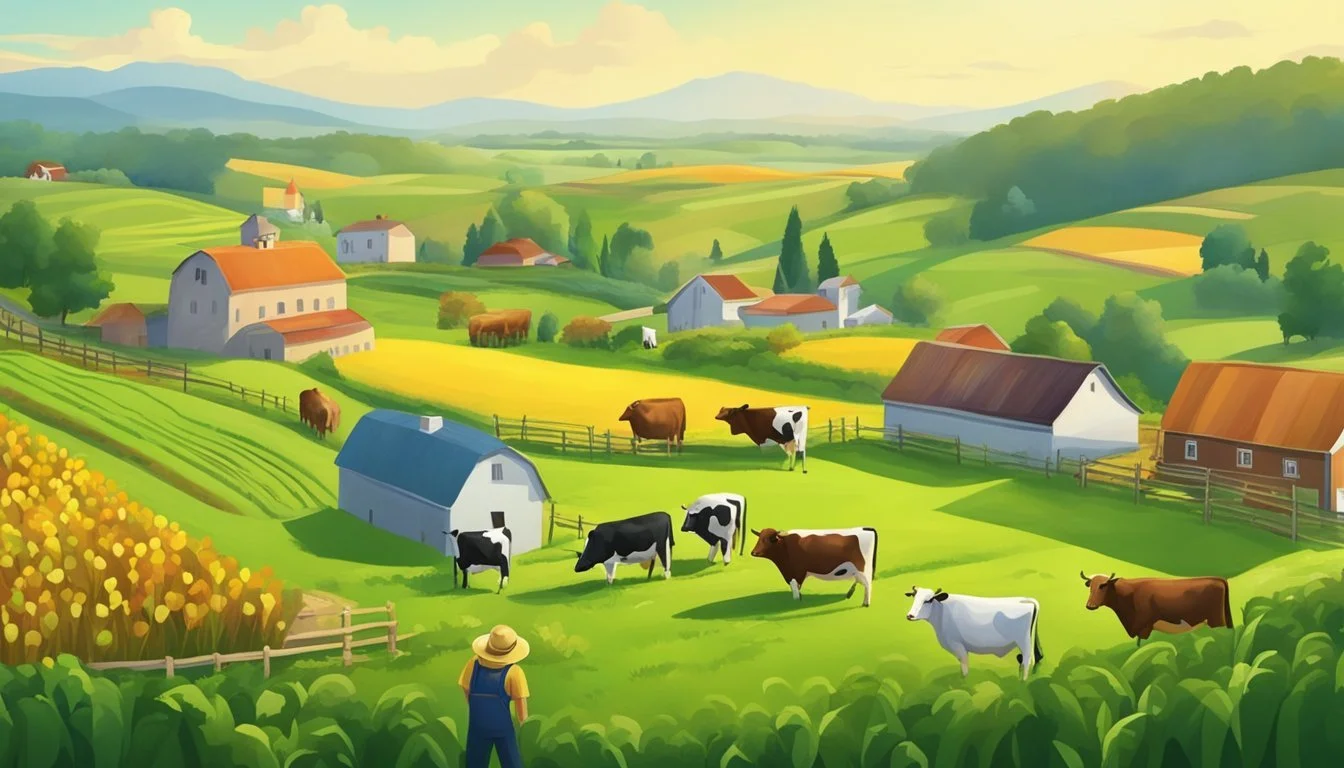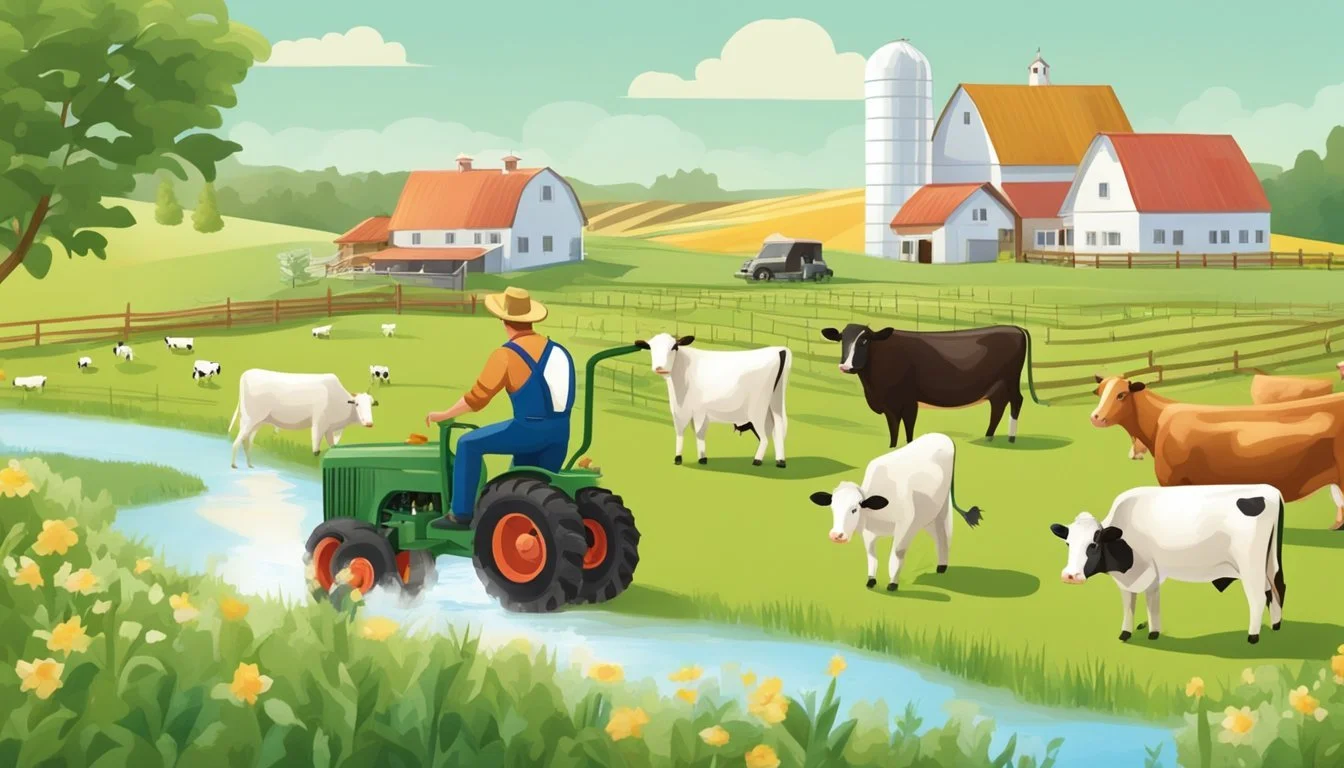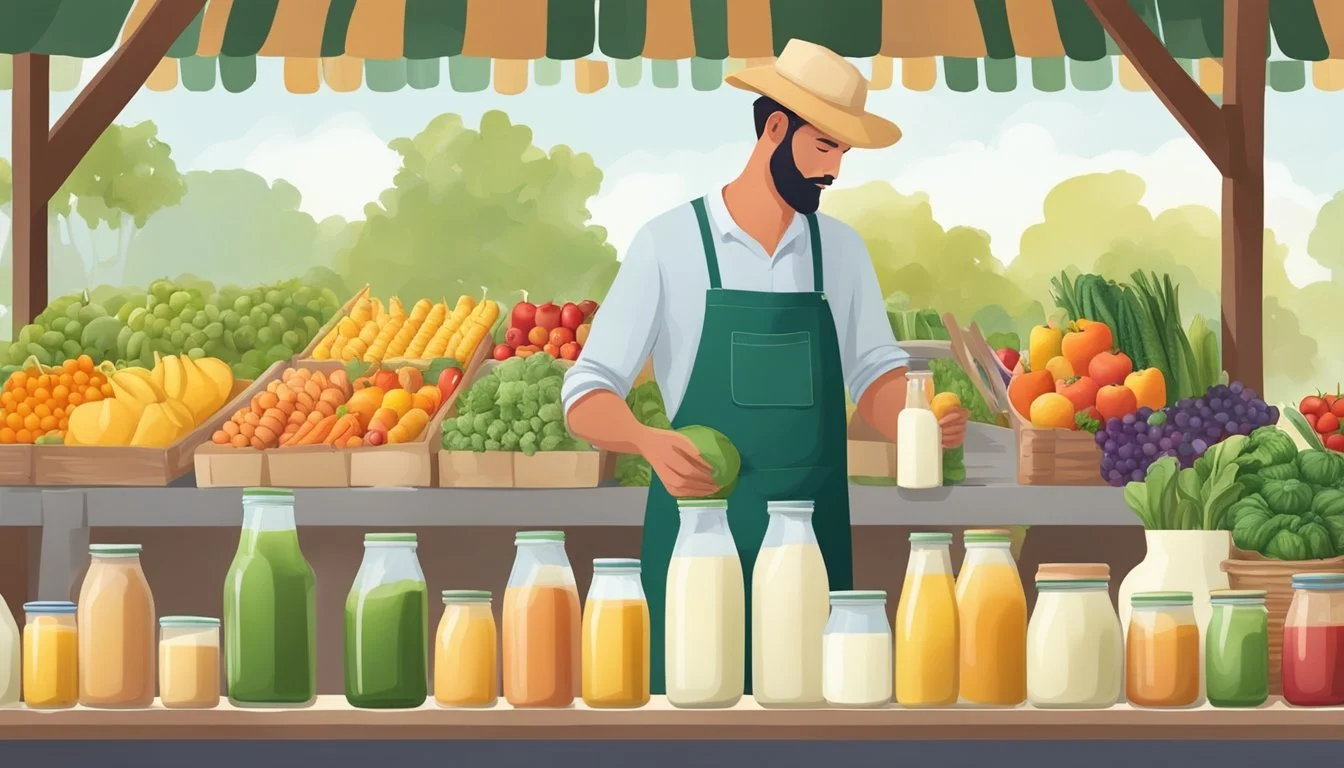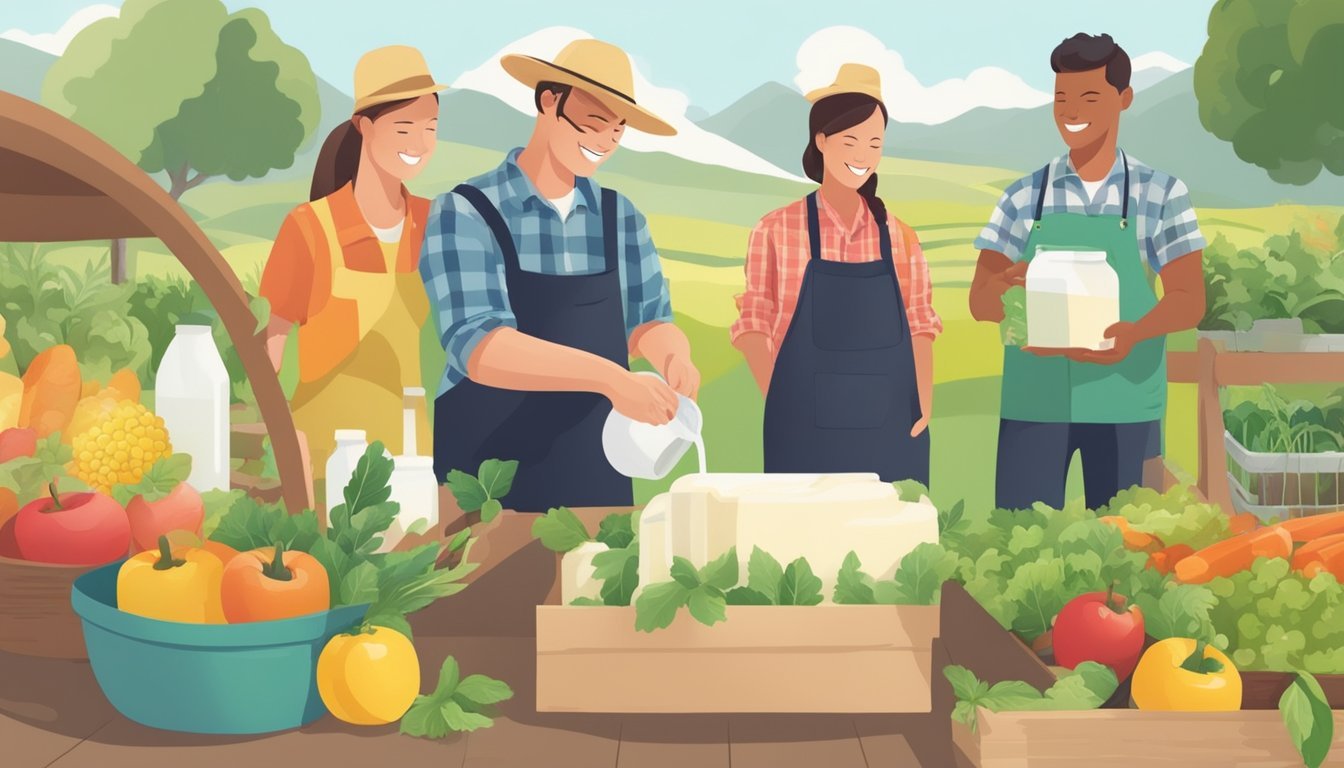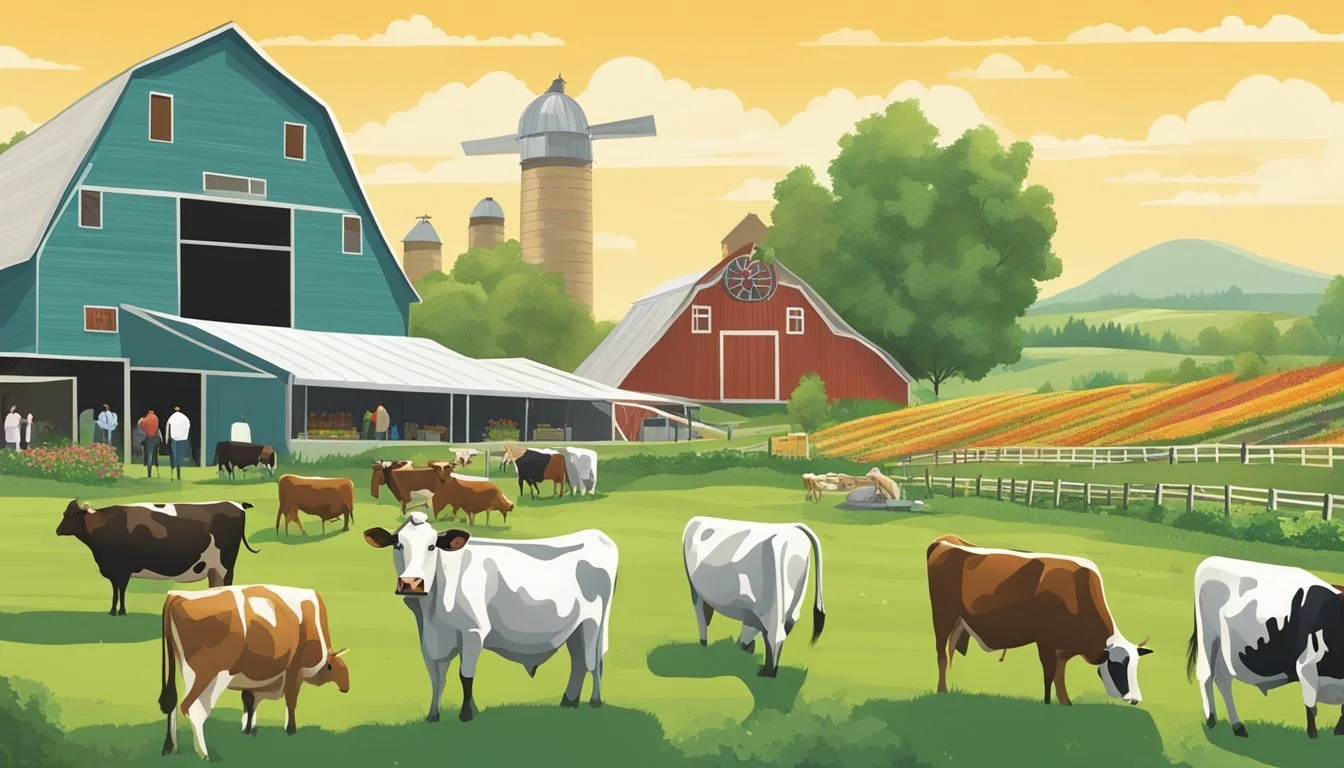Raw Milk and Community Supported Agriculture
Uniting for Sustainable Food Choices
Community Supported Agriculture (CSA) has increasingly become a popular model for fostering direct relationships between consumers and farmers. By purchasing a share in the farm's projected harvest, consumers receive a regular provision of fresh, locally produced food, often on a weekly basis. The CSA model not only supports local farmers financially by providing them with upfront capital, but it also shares the risks and bounty of agricultural production with the members. This collaborative approach has extended beyond fruits and vegetables, and raw milk—unpasteurized milk directly from the cow—has become part of this growing partnership for those wishing to deepen their connection with their food sources.
The integration of raw milk into the CSA framework aligns with a broader movement towards whole foods and transparency in the food system. Raw milk enthusiasts advocate for the taste, nutritional benefits, and the desire to maintain traditional food processing techniques. Despite the controversy surrounding raw milk due to potential health risks, a segment of consumers prefers raw milk for personal and health reasons. The merger of raw milk distribution with CSAs represents a synergy of values: community engagement, support for local agriculture, and a preference for minimal processing.
As the relationship between raw milk producers and CSA members strengthens, it illustrates the evolving landscape of consumer-farmer interactions. It underscores an earnest pursuit for food sovereignty and a closer knit food community wherein supporters of raw milk can have direct access to their desired product while ensuring they are contributing to the viability of their local farms. Through this growing partnership, consumers have the power to influence farming practices and the local economy, exemplifying a collective investment in the sustainability of their food systems.
Community Supported Agriculture (CSA) programs have become a popular way for individuals to access fresh and locally sourced produce, and this model has extended to include raw milk as well. Participating in a raw milk CSA not only supports local farmers but also provides numerous benefits for the community.
Families with young children can particularly benefit from raw milk for children through CSA programs. The nutritional value of raw milk is well-documented, and it can be a valuable source of essential vitamins and minerals for growing kids.
Moreover, being part of a raw milk CSA ensures that members have access to high-quality, fresh milk while also supporting raw milk preservation practices that maintain its nutritional integrity.
In addition to its benefits for children, raw milk offers potential advantages for skin conditions due to its natural enzymes and raw milk cleanse properties. By sourcing raw milk through a CSA, community members can enjoy these potential health benefits while also fostering a closer connection to local agriculture and sustainable food practices.
Overall, participating in a raw milk CSA not only promotes access to wholesome dairy products but also strengthens the bond between the community and local farmers, creating a win-win situation for all involved.
Evolution of Community Supported Agriculture
Community Supported Agriculture (CSA) has seen significant growth and evolution, rooted in a desire for sustainable and local farming practices. The origins of CSA trace back to collaborative efforts to support agriculture through direct partnerships between farmers and consumers.
Historical Background
CSA began in the early 1960s in Germany, Switzerland, and Japan due to concerns about food safety and the urbanization of agricultural land. The concept spread to the United States in the 1980s, driven by a growing interest in organic farming and sustainable agriculture. Robyn Van En, a pioneering farmer in Massachusetts, co-founded one of the first CSAs in the United States and played a pivotal role in promoting the CSA model.
Notable milestones in the CSA movement include:
The 1960s: Introduction of CSA concepts in Europe and Japan.
The 1980s: Robyn Van En co-founds Indian Line Farm, one of the first CSAs in the U.S.
The 1990s: Expansion of CSAs across the United States, bolstered by increased consumer interest in organic and locally-grown food.
Present: Thousands of CSAs now operate nationwide, supported by organizations like the Alternative Farming Systems Information Center, providing resources to new and existing CSA farms.
CSAs have evolved through various models, such as:
Subscriber-based CSAs, where individuals prepay for a season's worth of produce.
Market-style CSAs, allowing members more choice over what they receive.
The Alternative Farming Systems Information Center acts as a hub for disseminating information on CSAs, encouraging the growth of alternative farming systems which are economically and environmentally resilient.
Benefits of CSA to Local Agriculture
Community Supported Agriculture (CSA) is a partnership model that is shaping the future of local agriculture by reinforcing farm viability and sustainability. Through various mechanisms, CSAs provide significant benefits to farmers, local food systems, and the environment.
Supporting Local Farms
By offering shares of their harvest to community members, local farms gain upfront capital at the beginning of the growing season. This financial boost helps farmers in critical periods, enabling them to plan and invest in their crops with greater security. CSA members commit to supporting their local farmer regardless of the unpredictability of the season, thereby providing a stable source of income and reducing financial risk for farmers. In addition, direct sales through CSAs often yield higher returns for farmers compared to traditional wholesale avenues.
Strengthening Local Food Systems
CSAs play a crucial role in bolstering local food systems. They facilitate shorter supply chains, ensuring fresher produce making its way from farm to table. This model encourages a diverse array of crops, which can lead to better soil management and long-term sustainability for the land. By connecting consumers directly with their food sources, CSAs create a sense of community and accountability, fostering an environment where organic farming and sustainable agricultural practices can thrive.
Educational Opportunities: They provide a platform for farmers to educate community members about the importance of sustainable agriculture and permaculture principles.
Economic Benefits: CSAs contribute to the local economy by keeping the food dollars circulating within the community, supporting other local businesses.
Environmental Advantages
The environmental benefits of CSAs are closely linked with the principles of sustainable agriculture. Local farms often employ practices that are kind to the earth, such as organic pest control, water conservation, and composting which reduces reliance on harmful chemicals. These practices nurture the soil and biodiversity, which are cornerstones of environmental health. By reducing the need for long-distance transportation, CSAs also cut down on carbon emissions and fossil fuel usage, contributing to cleaner air and a lower carbon footprint.
Reduced Packaging: CSAs generally use minimal packaging compared to traditional retail, which lessens waste and pollution.
Conservation of Resources: They often promote responsible land and water use, aligning with environmental conservation efforts.
Operation of a CSA Model
The CSA model is a partnership where members fund the production of a farm's harvest in advance and in return, receive a share of fresh produce throughout the growing season. It outlines clear roles for members and farmers and ensures a steady distribution of goods.
Members' Role and Participation
Members play a critical role in a CSA model by providing upfront capital, which eases the financial pressure on farmers by covering initial production costs. Participation goes beyond financial contributions; members often engage in various facets of farm labor. They may partake in activities such as planting or packaging to cultivate a deeper understanding of the food production process.
Distribution of Harvest
Harvest distribution within a CSA is systematic and usually takes the form of a weekly fresh produce box. Each share corresponds to a fraction of the farm's yield and is often available for pickup at designated locations or delivered directly to members. This model ensures members receive a variety of seasonal produce directly after harvest, maximizing freshness.
Farmers' Responsibilities
Farmers shoulder the responsibilities of production planning, crop cultivation, and managing the administrational aspects of the CSA. They make crucial decisions about crop selection, employ sustainable farming practices, and commit to fulfilling the expectations of their membership base. Moreover, maintaining transparent communication with members about crop status and potential issues is paramount in sustaining trust and support.
Integrating Raw Milk Into CSAs
As Community Supported Agriculture (CSA) models gain popularity, integrating raw milk into CSA offerings presents both opportunities and challenges. This integration can enhance diet quality with nutritional benefits but requires careful consideration of legal frameworks and safety protocols to ensure a reliable supply chain.
Health and Nutrition Aspects
Raw milk is recognized for containing a range of nutrients such as proteins, vitamins, and minerals important for a balanced diet. Proponents argue that raw milk's enzymes and probiotics support digestion and overall health. However, it lacks pasteurization, a process that neutralizes potentially harmful bacteria, calling for meticulous handling to maintain health standards.
Legal and Safety Considerations
The sale of raw milk is subject to federal and state regulations due to safety concerns. The U.S. Department of Agriculture does not oversee raw milk directly, but federal law prohibits the sale of raw milk across state lines. Each state has its own laws regarding raw milk sales, and CSA members must ensure compliance. Safety is paramount; thus, raw milk must be produced and handled following stringent guidelines to minimize risks.
Supply Chain and Delivery
Incorporating raw milk into CSA expands the supply chain beyond traditional offerings like vegetables, fruits, eggs, and cheese. CSAs must establish a reliable, consistent delivery system to handle the perishability of raw milk. This involves refrigerated transport and swift distribution to maintain quality and ensure the milk reaches consumers promptly. Coordination with local producers becomes critical to adapt quickly to supply and demand fluctuations.
Economic and Social Impacts
The incorporation of raw milk into Community-Supported Agriculture (CSA) initiatives presents tangible economic and social benefits. Key economic impacts include cost savings and potential income streams for farmers, while socially, these partnerships foster community building and enhance food security.
Community Building
CSA programs excel in strengthening community ties, creating networks of members who regularly interact with each other and the farmers. This community aspect instills trust and a sense of collective responsibility. Community involvement goes beyond financial transactions, bringing together individuals with a shared commitment to supporting local agriculture and healthy food options.
Economic Benefits for Consumers and Farmers
From an economic standpoint, CSAs can provide significant savings for consumers and stable revenue for farmers. Customers often save money by paying upfront for a season's worth of farm produce, including raw milk, at a lower cost than retail. Farmers benefit from the direct-to-customer sales model, which can result in higher profit margins and reduced marketing costs. Additionally, during times of crisis, such as economic downturns or health pandemics, this model can provide an essential income stream for farmers.
Food Security and Accessibility
Community-Supported Agriculture, especially when coupled with raw milk sales, contributes to food security and accessibility. By ensuring a steady supply of fresh, healthy food directly to the consumer, CSAs can reduce reliance on traditional food banks and other emergency food programs. Furthermore, CSAs can help to meet the growing demand for alternative food networks that prioritize local, sustainable, and accessible food sources.
Consumer Perspectives on CSAs
Community Supported Agriculture (CSA) has garnered considerable attention for its role in transforming consumer purchasing habits and diet quality. Consumers participate in CSAs for various motivations, often leading to notable shifts in their food consumption patterns and an increased focus on health.
Motivations for Joining CSAs
Financial Support to Farmers: Consumers often join CSAs to provide direct financial support to local farmers, ensuring the sustainability of small-scale agriculture and contributing to the local economy.
Access to Fresh Produce: Members typically seek out CSAs to gain consistent access to a variety of fresh, locally-grown fruits and vegetables. The opportunity to receive weekly shipments of farm produce is an attractive feature.
Transparency and Trust: There is a growing concern among consumers regarding the origins and handling of their food. CSAs address this concern by offering transparency in food production and fostering trust between consumers and producers.
Environmental Sustainability: Individuals are motivated by the desire to reduce their carbon footprint. By participating in CSAs, they support farming practices that are generally more ecologically friendly.
Diet and Habits Transformation
Increased Consumption of Vegetables and Fruits: CSA members typically report an increase in their consumption of vegetables and fruits, attributing it to the regular supply of fresh produce.
Improved Diet Quality: With an abundance of fresh options readily available, members often experience an improvement in their overall diet quality. CSA produce is perceived as healthier compared to options available through conventional food systems.
Experimentation with New Foods: Exposure to a wider range of produce encourages consumers to try new items they may not have purchased independently, contributing to a more diverse diet.
Commitment to Healthy Eating: Regular deliveries from CSAs can foster a commitment to healthy eating habits as members feel more accountable to make good use of their shares, thus reducing food waste and improving health outcomes.
Challenges and Opportunities in CSA Farming
Community Supported Agriculture (CSA) is a collaborative endeavor between farmers and consumers that, while presenting several challenges, also offers numerous opportunities for innovation in agriculture.
Impact of Climate Change on CSA
Climate change constitutes a considerable challenge to CSA enterprises. Unpredictable weather patterns and the increasing incidence of extreme events, like droughts and floods, can lead to volatile yields and disrupt the delicate balance needed for CSAs to thrive. For instance, CSAs relying on biodynamic farming practices may face heightened local struggles as they work to maintain soil health amidst shifting climatic conditions.
Innovative Strategies and Opportunities
However, these challenges are met with innovative strategies that create opportunities for CSA farming. For example, adopting agriculture technologies that track weather patterns and soil health can help mitigate risks. Opportunities in CSA also arise from developing strong relationships with local consumers who value and support local food systems. Innovation in CSA can further be propelled by integrating biodynamics, an advanced form of regenerative farming, which focuses on ecological and sustainable approaches to agriculture. This method ties closely to CSA’s core values by enriching land resilience and fostering community involvement.
Educational Contributions
Raw milk initiatives within Community Supported Agriculture (CSA) programs have an intrinsic educational component that fosters both agricultural education at universities and increases community awareness.
Universities and Agricultural Education
University programs play a crucial role in cultivating a new generation of farmers through education about sustainable farming techniques and the CSA model. Courses specifically covering raw milk production often include:
Safety protocols and regulatory compliance
Benefits and risks associated with raw milk consumption
Sustainable practices in dairy farming
Such curricula enable students to grasp both the complexity of raw milk production and its place within local, sustainable food systems. As students learn, research, and potentially intern with CSA programs, they carry and disseminate this knowledge, fostering a more informed approach to dairy agriculture.
Community Awareness and Outreach
CSA initiatives contribute significantly to community awareness by engaging the public with:
Educational workshops and farm visits, allowing individuals to learn about raw milk's journey from cow to consumer.
Outreach campaigns that inform about the benefits of supporting local agriculture within a community.
These efforts promote a greater understanding of the interconnectedness of sustainable development and local food supply chains. By doing so, they enhance community involvement in CSAs, ensuring that more people are making informed decisions regarding raw milk and sustainable agriculture.
Policies and Legislation Affecting CSA and Raw Milk
Understanding the policies and legislation is essential for participants of Community Supported Agriculture (CSA) programs that distribute raw milk. Federal and state regulations have a significant impact on both CSA operations and the sale of raw milk.
Federal and State Guidelines
Federal Guidelines: The U.S. Food and Drug Administration (FDA) bans the sale of raw milk for human consumption across state lines; this is because raw milk can harbor dangerous microorganisms that can pose serious health risks. However, the FDA's regulations do not preempt state laws regarding the sale or distribution of raw milk.
State Guidelines: State policies vary widely. Some states allow the sale of raw milk at retail stores, while others only permit farm sales or require the consumer to partake in a herd-share agreement. The U.S. Department of Agriculture (USDA) does not directly regulate raw milk, but it does provide guidance on CSA operations.
States Permitting Retail Sales: Permit the sale of raw milk at retail outlets under strict guidelines to ensure safety.
States Permitting Farm Sales Only: Allow the sale of raw milk directly at the farm, sometimes requiring clear labeling that the milk is unpasteurized.
States With Herd-Share Agreements: Enable consumers to buy a share of a cow or herd and receive raw milk as part of the share.
Contracts and Agreements
Understanding the legal frameworks and contracts involved in CSA programs is crucial, particularly when they involve the distribution of raw milk.
CSA Contracts: A CSA contract typically outlines the expectations and obligations of both the farmer and the consumer. This may include the amount of produce provided, frequency of delivery, payment schedules, and shared risks.
Raw Milk Agreements: When raw milk is involved, contracts may also include indemnification clauses to protect the farmer, as well as clear statements regarding the inherent risks of consuming raw milk. Some states require specific disclaimers and acknowledgments.
Indemnification Clauses: Aim to shield the farmer from liability by gaining acknowledgment from consumers of the potential risks.
Risk Acknowledgment: Consumers often need to sign a document acknowledging the risks associated with consuming raw milk.
Legislation and policies influence how CSA programs operate and how raw milk is distributed. Participants must navigate these regulations carefully, with a clear understanding of what is required both federally and at the state level. Contracts and legal agreements can provide a structure to these transactions, helping to clarify responsibilities and manage risk.
Case Studies and Demographics
This section examines various case studies of Community Supported Agriculture (CSA) and the demographics involved in these partnerships with a special focus on their role in the raw milk movement.
Local CSA Examples
In California, raw milk has secured a unique place within CSA programs. A notable case study is Northern California's Organic Pastures, which offers raw milk shares directly to consumers. They not only operate outside of traditional supermarket structures but directly target health-conscious demographics looking for local foods. CSA members commit to purchasing raw milk before the season begins, ensuring a stable market for the organic farm.
Another case highlights a partnership between a southern California CSA and a local dairy farm providing raw milk. With the uptick in demand for local, organic products, the CSA's customer base appreciates the transparency and direct connection to their food source. These local CSA examples reflect a growing trend towards sustainability and a robust local food system.
Bibliometric Analysis and Data
A bibliometric analysis of recent studies demonstrates the expanding academic interest in CSA demographics and their consumer behaviors. This analysis reveals that:
CSA proponents are typically middle-class, educated individuals, driven by both health and environmental concerns.
There is a gender skew, with a higher participation rate among women.
Data also supports that raw milk consumers within the CSA community value the direct relationship with farmers, emphasizing the trust and quality associated with small-scale organic farms. Citing Hanson et al. (2019), this partnership fosters community resilience and strengthens ecological sustainability goals.
Future Outlook
This section examines the projected growth of Raw Milk within Community Supported Agriculture (CSA), focusing on emerging trends and the sustainability of market growth.
Trends in CSA Partnership
CSA programs have recently witnessed a trend towards incorporating raw milk into their offerings. This shift comes with a growing interest from consumers in both the health aspects and the desire to support local, less processed dairy production. Many CSA farms are exploring partnerships with raw milk producers to meet this demand.
Market Trends:
Increased Demand: Rising consumer interest in raw milk for its perceived health benefits.
Regulatory Changes: Adjustments in state regulations may allow wider raw milk distribution within CSAs.
Education and Awareness: CSA organizers are educating members on the benefits and risks of raw milk consumption.
Sustainable Practices and Market Potential
CSA's principle of sustainability and community support aligns closely with the ethos of raw milk production. Small-scale, ethical farming practices are inherently sustainable, and the integration of raw milk into CSA programs promises to reinforce this.
Economic Viability: Offering raw milk can potentially increase the economic viability of CSA farms by broadening their market appeal.
Environmental Impact: Careful management and low-impact farming associated with raw milk production reinforce CSA commitments to environmental stewardship.
Market Potential Indicators:
CSA Membership Growth: Indicative of the organic market expansion.
Consumer Trends: Shifting towards ethical, transparent food sourcing, increasing potential market size.
Local Focus: The local food movement solidifies CSAs and raw milk as a joint venture with considerable appeal.


